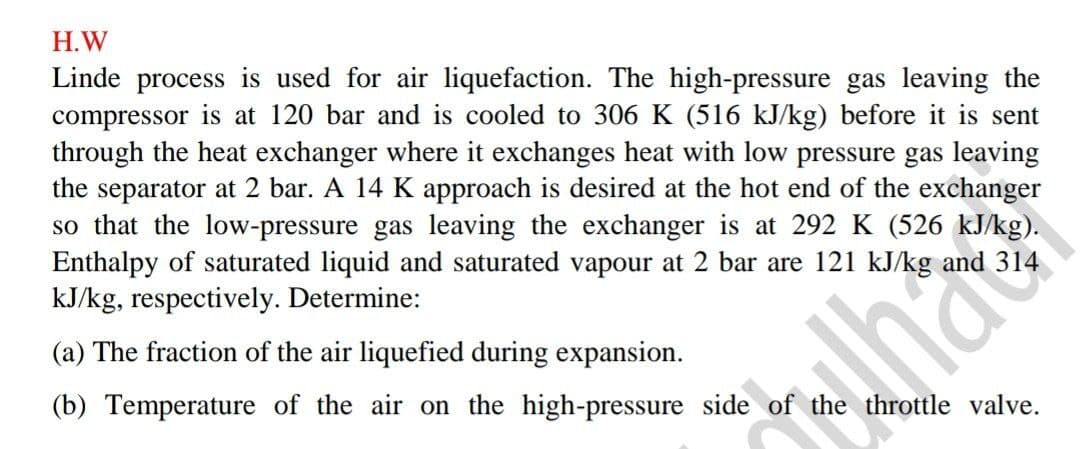HW Linde process is used for air liquefaction. The high-pressure gas leaving the compressor is at 120 bar and is cooled to 306 K (516 kJ/kg) before it is sent through the heat exchanger where it exchanges heat with low pressure gas leaving the separator at 2 bar. A 14 K approach is desired at the hot end of the exchanger so that the low-pressure gas leaving the exchanger is at 292 K (526 kJ/kg). Enthalpy of saturated liquid and saturated vapour at 2 bar are 121 kJ/kg and 314 kJ/kg, respectively. Determine: (a) The fraction of the air liquefied during expansion. (b) Temperature of the air on the high-pressure side of the throttle valve.
HW Linde process is used for air liquefaction. The high-pressure gas leaving the compressor is at 120 bar and is cooled to 306 K (516 kJ/kg) before it is sent through the heat exchanger where it exchanges heat with low pressure gas leaving the separator at 2 bar. A 14 K approach is desired at the hot end of the exchanger so that the low-pressure gas leaving the exchanger is at 292 K (526 kJ/kg). Enthalpy of saturated liquid and saturated vapour at 2 bar are 121 kJ/kg and 314 kJ/kg, respectively. Determine: (a) The fraction of the air liquefied during expansion. (b) Temperature of the air on the high-pressure side of the throttle valve.
Principles of Heat Transfer (Activate Learning with these NEW titles from Engineering!)
8th Edition
ISBN:9781305387102
Author:Kreith, Frank; Manglik, Raj M.
Publisher:Kreith, Frank; Manglik, Raj M.
Chapter10: Heat Exchangers
Section: Chapter Questions
Problem 10.17P
Related questions
Concept explainers
Heat Exchangers
Heat exchangers are the types of equipment that are primarily employed to transfer the thermal energy from one fluid to another, provided that one of the fluids should be at a higher thermal energy content than the other fluid.
Heat Exchanger
The heat exchanger is a combination of two words ''Heat'' and ''Exchanger''. It is a mechanical device that is used to exchange heat energy between two fluids.
Question
HW Linde process is used for air liquefaction. The high-pressure gas leaving the compressor is at 120 bar and is cooled to 306 K (516 kJ/kg) before it is sent through the heat exchanger where it exchanges heat with low pressure gas leaving the separator at 2 bar. A 14 K approach is desired at the hot end of the exchanger so that the low-pressure gas leaving the exchanger is at 292 K (526 kJ/kg). Enthalpy of saturated liquid and saturated vapour at 2 bar are 121 kJ/kg and 314 kJ/kg, respectively. Determine: (a) The fraction of the air liquefied during expansion. (b) Temperature of the air on the high-pressure side of the throttle valve.

Transcribed Image Text:H.W
Linde process is used for air liquefaction. The high-pressure gas leaving the
compressor is at 120 bar and is cooled to 306 K (516 kJ/kg) before it is sent
through the heat exchanger where it exchanges heat with low pressure gas leaving
the separator at 2 bar. A 14 K approach is desired at the hot end of the exchanger
so that the low-pressure gas leaving the exchanger is at 292 K (526 kJ/kg).
Enthalpy of saturated liquid and saturated vapour at 2 bar are 121 kJ/kg and
kJ/kg, respectively. Determine:
(a) The fraction of the air liquefied during expansion.
(b) Temperature of the air on the high-pressure side of the throttle valve.
Expert Solution
This question has been solved!
Explore an expertly crafted, step-by-step solution for a thorough understanding of key concepts.
Step by step
Solved in 2 steps with 1 images

Knowledge Booster
Learn more about
Need a deep-dive on the concept behind this application? Look no further. Learn more about this topic, mechanical-engineering and related others by exploring similar questions and additional content below.Recommended textbooks for you

Principles of Heat Transfer (Activate Learning wi…
Mechanical Engineering
ISBN:
9781305387102
Author:
Kreith, Frank; Manglik, Raj M.
Publisher:
Cengage Learning

Principles of Heat Transfer (Activate Learning wi…
Mechanical Engineering
ISBN:
9781305387102
Author:
Kreith, Frank; Manglik, Raj M.
Publisher:
Cengage Learning